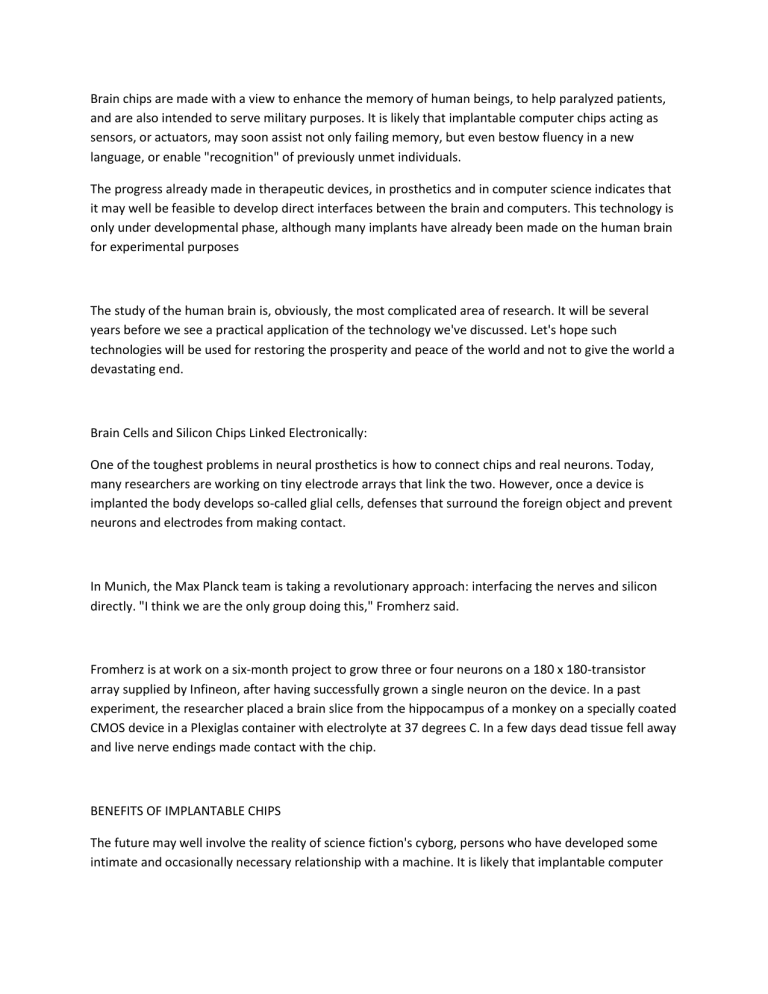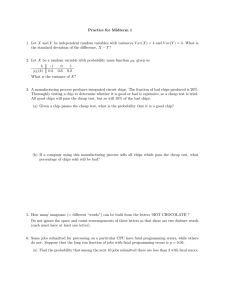Brain chips are made with a view to enhance the memory of human beings
advertisement

Brain chips are made with a view to enhance the memory of human beings, to help paralyzed patients, and are also intended to serve military purposes. It is likely that implantable computer chips acting as sensors, or actuators, may soon assist not only failing memory, but even bestow fluency in a new language, or enable "recognition" of previously unmet individuals. The progress already made in therapeutic devices, in prosthetics and in computer science indicates that it may well be feasible to develop direct interfaces between the brain and computers. This technology is only under developmental phase, although many implants have already been made on the human brain for experimental purposes The study of the human brain is, obviously, the most complicated area of research. It will be several years before we see a practical application of the technology we've discussed. Let's hope such technologies will be used for restoring the prosperity and peace of the world and not to give the world a devastating end. Brain Cells and Silicon Chips Linked Electronically: One of the toughest problems in neural prosthetics is how to connect chips and real neurons. Today, many researchers are working on tiny electrode arrays that link the two. However, once a device is implanted the body develops so-called glial cells, defenses that surround the foreign object and prevent neurons and electrodes from making contact. In Munich, the Max Planck team is taking a revolutionary approach: interfacing the nerves and silicon directly. "I think we are the only group doing this," Fromherz said. Fromherz is at work on a six-month project to grow three or four neurons on a 180 x 180-transistor array supplied by Infineon, after having successfully grown a single neuron on the device. In a past experiment, the researcher placed a brain slice from the hippocampus of a monkey on a specially coated CMOS device in a Plexiglas container with electrolyte at 37 degrees C. In a few days dead tissue fell away and live nerve endings made contact with the chip. BENEFITS OF IMPLANTABLE CHIPS The future may well involve the reality of science fiction's cyborg, persons who have developed some intimate and occasionally necessary relationship with a machine. It is likely that implantable computer chips acting as sensors, or actuators, may soon assist not only failing memory, but even bestow fluency in a new language, or enable "recognition" of previously unmet individuals. Brain Chips Technology The progress already made in therapeutic devices, in prosthetics and in computer science indicates that it may well be feasible to develop direct interfaces between the brain and computers. Computer scientists predict that within the next twenty years neural interfaces will be designed that will not only increase the dynamic range of senses, but will also enhance memory and enable "cyberthink" - invisible communication with others. This technology will facilitate consistent and constant access to information when and where it is needed. The linkage of smaller, lighter, and more powerful computer systems with radio technologies will enable users to access information and communicate anywhere or anytime. Through miniaturization of components, systems have been generated that are wearable and nearly invisible, so that individuals, supported by a personal information structure, can move about and interact freely, as well as, through networking, share experiences with others. The wearable computer project envisions users accessing the Remembrance Agent of a large communally based data source. As intelligence or sensory "amplifiers", the implantable chip will generate at least four benefits: • It will increase the dynamic range of senses, enabling, for example, seeing IR, UV, and chemical spectra; • It will enhance memory; • It will enable "cyberthink" - invisible communication with others when making decisions, and • It will enable consistent and constant access to information where and when it is needed. For many these enhancements will produce major improvements in the quality of life, or their survivability, or their performance in a job. The first prototype devices for these improvements in human functioning should be available in five years, with the military prototypes starting within ten years, and information workers using prototypes within fifteen years; general adoption will take roughly twenty to thirty years. The brain chip will probably function as a prosthetic cortical implant. The user's visual cortex will receive stimulation from a computer based either on what a camera sees or based on an artificial "window" interface. Retinomorphic Chips: The famed mathematician Alan Turing predicted in 1950 that computers would match wits with humans by the end of the century. In the following decades, researchers in the new field of artificial intelligence worked hard to fulfill his prophecy, mostly following a top-down strategy: If we can just write enough code, they reasoned, we can simulate all the functions of the brain. The results have been dismal. Rapid improvements in computer power have yielded nothing resembling a thinking machine that can write music or run a company, much less unlock the secrets of consciousness. Kwabena Boahen, a lead researcher at the University of Pennsylvania's Neuroengineering Research Laboratory, is trying a different solution. Rather than imposing pseudo-smart software on a conventional silicon chip, he is studying the way human neurons are interconnected. Then he hopes to build electronic systems that re-create the results. In short, he is attempting to reverse-engineer the brain from the bottom up. Boahen and his fellow neuromorphic engineers are now discovering that the brain's underlying structure is much simpler than the behaviors, insights, and feelings it incites. That is because our brains, unlike desktop computers, constantly change their own connections to revamp the way they process information. "We now have microscopes that can see individual connections between neurons. They show that the brain can retract connections and make new ones in minutes. The brain deals with complexity by wiring itself up on the fly, based on the activity going on around it," Boahen says. That helps explain how three pounds of neurons, drawing hardly any more power than a night-light, can perform all the operations associated with human thought. Brain Chips Technology The first product from Boahen's lab is a retinomorphic chip, which he is now putting through a battery of simple vision tests. Containing nearly 6,000 photoreceptors and 4,000 synthetic nerve connections, the chip is about one-eighth the size of a human retina. Just as impressive, the chip consumes only 0.06 watt of power, making it roughly three times as efficient as the real thing. A general-purpose digital computer, in contrast, uses a million times more energy per computation as does the human brain. "Building neural prostheses requires us to match the efficiency, not just the performance, of the brain," says Boahen. A retinal chip could be mounted inside an eyeball in a year or two, he says, after engineers solve the remaining challenges of building an efficient human-chip interface and a compact power supply. Remarkable as an artificial retina might be, it is just a baby step toward the big objective—reverseengineering the brain's entire ornate structure down to the last dendrite. A thorough simulation would require a minutely detailed neural blueprint of the brain, from brain stem to frontal lobes. The Lab-rat and The Monkey: Rats steered by a computer…could soon help find buried earthquake victims or dispose of bombs, scientists said [1 May 2002]. The remote-controlled “roborats” can be made to run, climb, jump or turn left and right through electrical probes, the width of a hair, implanted in their brains. Movement signals are transmitted from a computer to the rat’s brain via a radio receiver strapped to its back. One electrode stimulates the “feelgood” center of the rat’s brain, while two other electrodes activate the cerebral regions which process signals from its left and right whiskers. “They work for pleasure,” says Sanjiv Talwar, the bioengineer at the State University of New York who led the research team.… “The rat feels nirvana.” Asked to speculate on potential military uses for robotic animals, Dr Talwar agreed they could, in theory, be put to some unpleasant uses, such as assassination Rat implants Scientists say they have developed a technology that enables a monkey to move a cursor on a computer screen simply by thinking about it.… Using high-tech brain scans, the researchers determined that small clump of cells…were active in the formation of the desire to carry out specific body movements. Armed with this knowledge, [researchers at the California Institute of Technology in Pasadena] implanted sensitive electrodes in the posterior parietal cortex of a rhesus monkey trained to play a simple video game.… A computer program, hooked up to the implanted electrodes,…then moved a cursor on the computer screen in accordance with the monkey’s desires — left or right, up or down, wherever “the electrical (brain) patterns tells us the monkey is planning to reach,” according to [researcher Daniella] Meeker. [Dr. William Heetderks, director of the neural prosthesis program at the National Institute of Neurological Disorders and Stroke,] believes that the path to long-lasting implants in people would involve the recording of data from many electrodes. “To get a rich signal that allows you to move a limb in three-dimensional space or move a cursor around on a screen will require the ability to record from at least 30 neurons,” he said.


